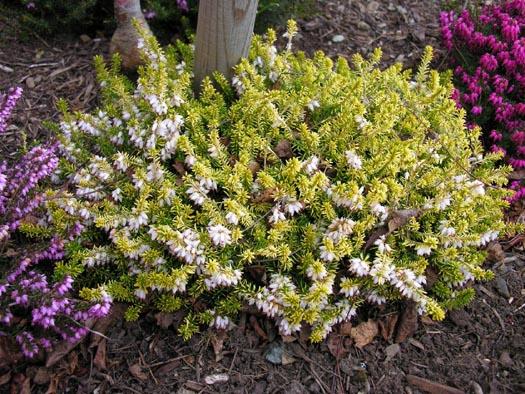There are few plants which perform as consistently has heather in the garden.
When planted they last for many years and will flower and grow year after year… IF… you get to know your Callunas from your Ericas.
Callunas are wonderful heathers which are in flower now in the garden centres, they’re generally brilliant white or bright pink and will 100% catch your eye when you see them. Ideal for planting into pots and containers for winter colour interest these will flower during the Autumn and Winter months, looking wonderful as they do it. After flowering, you’re best to discard the plant.
When planted in the garden they get tall and woody and not at all attractive, and they need a really peaty soil in which to exist in… so wonderful, amazing for the short term but a hassle long term.
Erica is another genus of Heathers which grow much lower than Calluna, and are tolerant of a wide range of soil types. Erica grow more like a carpet than the more upright Calluna, so are wonderful when planted in groups in borders and for long-term display in containers and pots.

A wonderful display of Ericas in Flower at RHS Harlow Carr
Available in White, Pinks and Purples there Ericas produce buds from Autumn through the Winter and then these open in the Spring months. These open flowers are a magnet for bees in the springtime.
In addition to the Pinks and Purples there is also an attractive range of foliage colours, from dark to light green and some golden colours mixed in.
So with careful selection of varieties, you can end up with a nice colourful area of the garden all year round when you combine the foliage and flower colours. Add in some dwarf conifers such as the orangey tones Thuja Rheingold and the Blue Juniper Blue Star and some dwarf Narcissus and draw Tulips and you have the making of a fine display of colour.
When planting in the garden it’s important for impact that you plant Ericas in groups of 3/5/7 etc, this will give you much greater impact and much less overall maintenance.
The only real maintenance that Ericas need is a light trim when they go out of flowering (this keeps them squatter and thicker), and if the centre of the plant starts to go sparse with age, just cover it well with some compost and the plant will self-layer and grow back fresh again in the centre.
The challenge with Ericas is that they’re not 2 metres high with flowers the size of your head, they don’t jump out and blaze flowers in your face, they just do what they do nice and consistently and all but a few weeks in the year you may never pay them much attention but they’re certainly worthy of being added to your garden.
Tags:







